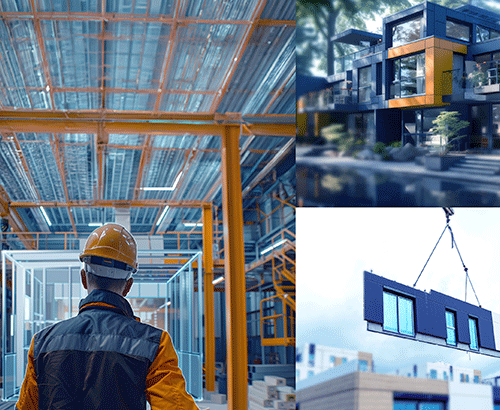Addressing the Workforce Gaps and Related Risks for the E&C Industry

Assessing the role of emerging technologies in easing workforce gaps for engineering and construction firms.
The robust construction industry projections for 2018 (FMI forecasts a 5% increase in total spending this year over 20171) are being tempered by the continuing challenges of a shrinking workforce. Although a Bureau of Labor Statistics report from January 2018 projects construction employment to grow 12% through 2026, faster than the average for all occupations, filling jobs will continue to vex an industry that’s ready to hit the gas pedal.
In an Associated General Contractors of America (AGC) survey, 70% of construction firms reported difficulty filling the hourly craft positions that represent the bulk of the construction workforce, and the majority foresaw continuing hardships in the future.2 In addition, the AGC estimates that 3.7 million construction workers will be approaching retirement age by 2027, with a smaller pool of younger workers with the skills to replace them.3
An Industry That’s Innovating
Industry innovations couldn’t come at a better time, particularly as engineering and construction (E&C) projects become more complex and demanding. Technology, modularization, and project delivery and management—all of which can increase productivity, communication and efficiency—can help fill the gaps created by a smaller workforce. Some of these tools can also help mitigate risk by replacing onerous and/or dangerous tasks previously performed by workers. Finally, implementing this technology can help attract a younger generation that is not only equipped to do the work but also excited about the possibilities.
Yes, technology can be costly. Yes, it’s constantly evolving, demanding flexibility and nimbleness on the parts of stakeholders. However, technology is a reality. And as it continues to evolve, E&C firms need to keep pace with the competition.
Though technology does impact upfront expenses, a recent study showed that if E&C companies can help close the global labor-productivity gap in construction using these new tools and solutions, the industry’s output would increase by $1.6 trillion per year.4
It’s also worth noting the costs associated with having too few workers. A Construction Industry Institute report linked workforce shortages to risks in three key elements of project execution. The report found that depending on their severity, labor shortages could negatively affect safety, raise costs by creating project escalations of more than 17%, and adversely impact schedules, causing projects to experience delays of more than 22%.5
Many of the emerging technologies and innovations available to E&C can help address these profound shortages. Though some—such as drones—may be familiar, their potential continues to evolve in newfound ways. Here are snapshots of some of the most exciting developments.
Technology
- Building Information Modeling (BIM) has arguably been one of the most important technological advancements in the E&C industry. The three-dimensional successor to Computer-Aided Design and Drafting (CADD), BIM has revolutionized the way structures are designed and built. A design team can now “virtually” create an entire project down to the last minor detail before even putting a shovel into the ground. A 3-D virtual reality walkthrough of the project can be performed to check design details, functionality, constructability and clash detection. In an article focused on design and construction, Digitalist Magazine reported, “SAP estimates that this digital process for facility life cycle management will result in 10% fewer engineering changes, 45% less rework and 79% lower accident frequency.”6
BIM allows all the various subcontractors and suppliers to provide input for their particular components. Any changes can be made prior to the start of fabrications. The model also can incorporate a timeline for schedule, labor and cash flow, creating substantial financial efficiencies.
- Robotics includes any type of machinery that enhances or replaces the human worker. Under this definition, a power tool, bulldozer or excavator could be considered as a type of robotic. Looking ahead, the newer technologies fall under the prime categories of “autonomous” and “assistive.” Much of this technology is still very new but is poised to transform the industry.
Autonomous robotics refers to machines that can perform semi-complex tasks with minimum human oversight. Examples could include robotic bricklaying equipment, reinforcing bar-tying machines, laser-guided graders and excavators.
Assistive robotics encompasses the self-supporting exoskeleton type of apparatus that workers wear to enhance their lifting and carrying capabilities and help prevent fatigue and injuries. These robots bring the technology used in the manufacturing industry out to the job site. In addition to improving worker safety, these devices can increase productivity.
- 3-D building printers, which can also be considered a type of robot, function similarly to commercially available small-object printers but on a much larger scale. Utilizing a flowable, fast-setting concrete-type media, these printers are primarily used for footings and walls. Their advantages include a reduction in overall time and labor, elimination of formwork, ability to print complex-shaped structures, and fewer layout errors. 3-D printers remain an emerging technology, but tremendous advances have been made in the past few years, with many unique and functional structures having already been printed.
- Unmanned Aircraft Systems (UASs) are commonly (and somewhat incorrectly) referred to as drones. This technology has probably experienced one of the biggest growth areas in construction. Drones (aka unmanned aerial vehicles, or UAVs) started out taking progress photos of a project. Today, equipped with a wide array of software applications and cameras, UAS’ potential has blossomed: They still capture progress photos, but they also can overlay that information with the BIM model, letting engineers and contractors see what they envisioned against what actually exists. It doesn’t stop there; monitoring various types of measurements, safety, quality control and worksite security are just a few additional benefits.
- Wearable device systems worn by employees (attached to clothing or on safety equipment, such as hardhats) keep everyone connected and help improve efficiency, productivity and safety. Smart goggles can use augmented reality to access a BIM model with the blink of an eye. Wearables can capture and monitor data in real time, such as determining workers’ precise locations and movements to identify workflow efficiencies, locating workers in the event of an emergency, alerting personnel when they’re entering a restricted area, or performing a task in an ergonomically harmful way.
Modularization
Modularization, which allows a building’s components to be produced in a controlled, off-site environment, can be a boon to an industry grappling with workforce shortages, tighter schedules and the subsequent threat of schedule delays. In addition to construction taking place at the same time as site and foundation work, building in a controlled environment provides many other benefits, including: a greater likelihood of producing a more consistent-quality product, less work to do out on the job site itself, lower turnover rate of workers when compared to the turnover on job sites, and a decrease of weather challenges. Modularization also facilitates prefabrication, another antidote to E&C’s emerging needs that also delivers increased efficiency, consistency and safer working conditions.
Project Management and Delivery
Innovative project delivery and management methods such as design-build, integrated project delivery, lean and bundling will continue to grow in popularity as owners, engineers and constructors experiment with ways to more successfully deliver projects. Here are two that we think deserve attention:
- Lean project delivery (LPD) was brought into the design and construction fields as a response to the dissatisfaction of stakeholders in the industry. Compared to many other industries, construction labor efficiency and productivity continue to be a challenge.
LPD seeks to improve project outcomes by fostering collaboration, enhancing accountability, reducing waste, ensuring a smooth flow of value-added activities and encouraging continual improvement in the preconstruction and construction processes. Lean construction is a production management-based approach to project delivery that changes the way work is done throughout the delivery process, extends from the objectives of a lean production system utilizing specific techniques, and applies them in a new project delivery process. Lean tools and concepts commonly used on projects include daily stand-up meetings, weekly work planning, pull planning, six-week make-ready schedules, prefabrication of construction material, just-in-time deliveries and “nothing hits the ground” concepts.
- Prevention through Design (PtD) was developed in the industrial and manufacturing industries to ensure that safe work environments were incorporated into the layout and design of a new or renovated facility. An emerging practice in construction, PtD finds designers and contractors—early in the design process—improving job-site safety by using BIM, wearable devices, robotics and UASs to eliminate many of the hazards normally encountered on a job site.
The design phase includes elements that may incorporate a plan for safe access or egress to confined or elevated areas, tie-off points on structural elements, and the movement of equipment and material. Employers pay almost $170 billion per year in costs associated with occupational injuries and illnesses; OSHA estimates that safety and health management initiatives can help save 20 to 40% of these costs.7
More to Come
Data and information collaboration, always an essential part of any project, will be transformed in the coming years. A common thread linking all these new technologies and innovations is the availability of enormous amounts of data, with information being collected at a high rate of speed from multiple sources. Collaborative cloud platforms enable project participants located around the world to instantly receive and respond to the updates, questions and issues that typically arise during a project. This world of shared data creates opportunities for a new kind of construction worker, offsetting the challenges as the E&C industry builds for the future.
Disclaimer
The information in this publication was compiled from sources believed to be reliable for informational purposes only. All sample policies and procedures herein should serve as a guideline, which you can use to create your own policies and procedures. We trust that you will customize these samples to reflect your own operations and believe that these samples may serve as a helpful platform for this endeavor. Any and all information contained herein is not intended to constitute advice (particularly not legal advice). Accordingly, persons requiring advice should consult independent advisors when developing programs and policies. We do not guarantee the accuracy of this information or any results and further assume no liability in connection with this publication and sample policies and procedures, including any information, methods or safety suggestions contained herein. We undertake no obligation to publicly update or revise any of this information, whether to reflect new information, future developments, events or circumstances or otherwise. Moreover, Zurich reminds you that this cannot be assumed to contain every acceptable safety and compliance procedure or that additional procedures might not be appropriate under the circumstances. The subject matter of this publication is not tied to any specific insurance product nor will adopting these policies and procedures ensure coverage under any insurance policy.
© 2018 Zurich American Insurance Company. All rights reserved.
Jon Tate is vice president of construction, The Zurich Services Corporation—Risk Engineering.
1 “2018 FMI Overview.” FMI. 26 January 2018.
2 “Seventy Percent of Contractors Have a Hard Time Finding Qualified Craft Workers to Hire Amid Growing Construction Demand, National Survey Finds.” The Associated General Contractors of America. 29 August 2017.
3 “Preparing the Next Generation of Skilled Construction Workers: Workforce Development Plan.” The Associated General Contractors of America. 2017.
4 Excerpted from “The New Age of Engineering and Construction Technology.” McKinsey & Company, www.mckinsey.com. July 2017. ©2018 McKinsey & Company. All rights reserved. Reprinted by permission.
5 “Is There a Demographic Labor Cliff that Will Affect Project Performance?” Construction Industry Institute. 1 September 2015.
6 Clemmons, Johnny. “Facility Life Cycle Management: BIM benefits for Design & Construction.” Digitalist Magazine. 25 August 2016.
7 Occupational Safety & Health Administration. “Safety and Health Add Value to Your Business.”

.jpg)

